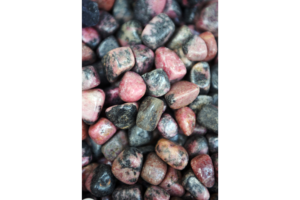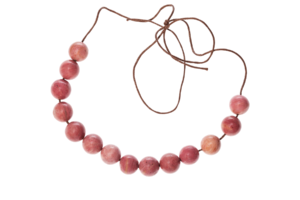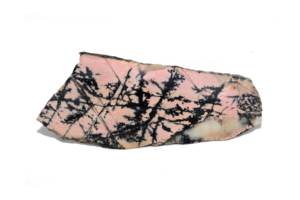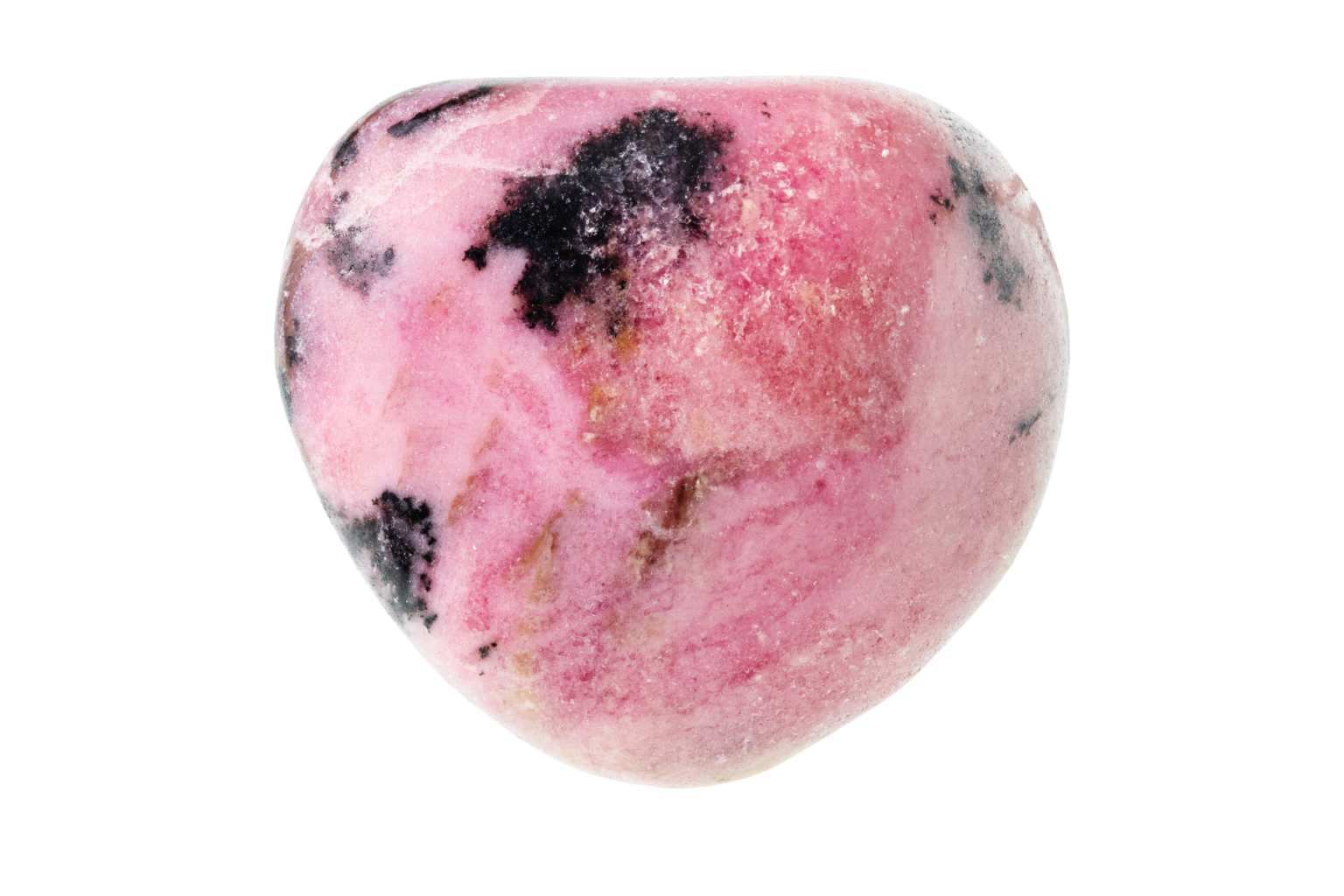What’s rhodonite?
Rhodonite is a pink to red mineral that is primarily composed of manganese silicate. It is commonly found in metamorphic rocks, especially those that have undergone intense heat and pressure. Rhodonite has a distinct pink color, which can range from pale to dark pink, and is often marked with black veins or spots of manganese oxide.
In addition to its beauty, rhodonite has been valued for its healing properties. It is believed to help promote emotional balance, reduce stress and anxiety, and increase self-confidence. Some people also use rhodonite as a meditation aid or as a tool for spiritual growth. Rhodonite is often used in jewelry making and as a decorative stone in carvings and sculptures.
Rhodonite is typically opaque and has a vitreous (glassy) luster. It is a relatively hard mineral, with a Mohs hardness of 5.5 to 6.5, which means that it can be scratched by harder materials like quartz but can scratch softer materials like gypsum.
How is rhodonite formed?
Rhodonite is a mineral that forms in metamorphic rocks, which are rocks that have undergone intense heat and pressure over time. It typically forms in high-temperature, low-pressure environments such as contact metamorphic zones where hot magma or lava comes into contact with existing rock formations, or in regional metamorphic zones where large areas of rock are subjected to high temperatures and pressure over long periods of time.
Rhodonite is primarily composed of manganese silicate, which forms when the mineral rhodonite combines with other minerals such as pyroxene or garnet during metamorphism. The pink color of rhodonite comes from the presence of manganese, while the black veins or spots are formed by manganese oxide.
Rhodonite can also be formed through hydrothermal processes, where hot, mineral-rich fluids seep through cracks and fissures in existing rock formations and deposit minerals in the surrounding rock.
Overall, rhodonite forms in environments where there is high heat, pressure, and mineral-rich fluids, and it typically occurs in association with other minerals such as quartz, feldspar, and mica.
 The Chakra
The Chakra
Rhodonite is associated with the heart chakra, which is the fourth chakra in the body’s energy system. The heart chakra is located in the center of the chest and is associated with love, compassion, and emotional well-being.
When the heart chakra is balanced and open, it is said to promote feelings of love, empathy, and compassion for oneself and others. It is also believed to help individuals develop a greater sense of inner peace and emotional balance.
Rhodonite is said to help open and balance the heart chakra, promoting emotional healing and well-being. It is believed to help individuals connect with their own feelings and emotions, as well as those of others, and to develop a deeper sense of empathy and compassion.
Healing Properties of Rhodonite
It is important to note that the healing properties of rhodonite are based on spiritual beliefs and not scientific evidence. With that being said, some people believe that rhodonite can help with emotional healing and balance.
Rhodonite is believed to have a calming effect on the emotions, reducing stress and anxiety. It is said to help soothe emotional wounds and promote forgiveness, both of oneself and others. Rhodonite is also believed to increase self-esteem and confidence, allowing individuals to better recognize their own worth and value.
In addition, some people believe that rhodonite can help improve relationships by promoting forgiveness, compassion, and understanding. It is said to encourage selfless love and help individuals develop a deeper understanding of others’ perspectives.
Rhodonite is sometimes used in meditation practices as a tool to help connect with the heart chakra, which is associated with emotional well-being, love, and compassion. It is said to help individuals develop a deeper sense of empathy and compassion for themselves and others.
Can rhodonite be cleansed?
Yes, rhodonite can be cleansed. Cleansing is a process of removing any negative energies or vibrations that the stone may have absorbed and recharging it with positive energy. Here are a few ways to cleanse rhodonite:
- Water: You can cleanse rhodonite by holding it under running water for a few minutes. Make sure to dry it thoroughly afterwards.
- Smudging: You can use smoke from burning herbs such as sage, palo santo, or cedar to cleanse rhodonite. Simply hold the stone in the smoke for a few minutes.
- Salt: You can also cleanse rhodonite by burying it in a bowl of sea salt or Himalayan salt. Leave the stone in the salt for a few hours or overnight, then rinse it off and dry it thoroughly.
- Sunlight and Moonlight: You can also place rhodonite in sunlight or moonlight for a few hours to cleanse it. It is recommended to place it in a windowsill or outside in a safe place.
It is important to note that some methods of cleansing, such as water or salt, may not be suitable for certain types of rhodonite, such as those that are porous or contain metals that can rust or corrode. If you are unsure about the best way to cleanse your rhodonite, it is best to consult a reputable crystal healer or do some research to find the most suitable method for your particular stone.
Is rhodonite a birthstone?
Rhodonite is not considered to be an official birthstone for any month, according to the modern birthstone list that was established by the American Gem Society. However, some people believe that rhodonite can be used as a birthstone alternative for the zodiac sign of Taurus, which falls between April 20th and May 20th.
In addition to being associated with Taurus, rhodonite is sometimes associated with the astrological sign of Aries (March 21st – April 19th) and is sometimes used as a talisman or amulet for people born under those signs.
It is important to note that birthstones and their associations are often based on cultural and historical traditions and are not necessarily based on scientific or metaphysical properties. Some people choose to use birthstones or other gemstones based on their personal preferences, spiritual beliefs, or other factors.
 Harnessing the Positive Energy
Harnessing the Positive Energy
Some people believe that rhodonite has a positive energy that can be harnessed and used for various purposes. Here are a few ways that you can harness the energy of rhodonite:
- Wear it: One of the most popular ways to harness the energy of rhodonite is to wear it as jewelry. You can wear it as a pendant, ring, bracelet, or earrings to keep it close to your body and benefit from its energy throughout the day.
- Meditate with it: You can hold a piece of rhodonite in your hand while meditating to help you connect with its energy and promote feelings of calm and emotional balance.
- Place it in your home: You can place rhodonite in a prominent location in your home, such as on a shelf or table, to promote a peaceful and loving environment.
- Carry it with you: You can carry a small piece of rhodonite in your pocket or purse to help you stay centered and balanced throughout the day.
Where can rhodonite be found?
Rhodonite can be found in many locations around the world, including:
- Russia: The Ural Mountains in Russia are a significant source of high-quality rhodonite.
- Peru: Peru is another significant source of rhodonite, particularly in the form of large, gem-quality crystals.
- Canada: Rhodonite is found in several locations throughout Canada, including Ontario, Quebec, and British Columbia.
- United States: Rhodonite has been found in several locations throughout the United States, including Colorado, Massachusetts, New Jersey, and California.
- Argentina: Rhodonite is found in the Andes Mountains in Argentina, where it is often associated with other minerals such as pyrite and quartz.
- Brazil: Rhodonite is also found in Brazil, particularly in the Minas Gerais region.
- Sweden: Rhodonite has been found in several locations throughout Sweden, including the Falun mine.
Overall, rhodonite can be found in many locations around the world, and its beauty and unique coloration make it a popular choice for jewelry and decorative purposes.
What has rhodonite been used for throughout history?
Rhodonite has been used for various purposes throughout history. Here are a few notable examples:
- Ancient civilizations: Rhodonite was used by ancient civilizations such as the Greeks and the Romans for decorative purposes. It was often carved into cameos, intaglios, and other ornamental objects.
- 19th century Russia: Rhodonite gained popularity in the 19th century in Russia, where it was used to decorate buildings, churches, and palaces. It was also used to make jewelry, decorative objects, and tableware.
- Healing properties: Rhodonite has been valued for its healing properties for centuries. In ancient China, it was believed to have anti-inflammatory and detoxifying effects. In more recent times, it has been used as a tool for emotional healing and balance.
- Spiritual properties: Rhodonite is associated with the heart chakra and is believed to promote feelings of love, compassion, and emotional healing. It is often used in meditation practices to promote a deeper sense of empathy and understanding.
- Industrial uses: Rhodonite has also been used in various industrial applications, such as as a source of manganese and as a material for making furnace linings and refractory bricks.
 Summary
Summary
Rhodonite is a mineral that is primarily composed of manganese silicate and has a distinctive pink to reddish-pink color, often marked with black veins or spots of manganese oxide. It is commonly found in metamorphic rocks and is often used in jewelry making and as a decorative stone.
Some people believe that rhodonite has healing properties, particularly related to emotional balance, stress reduction, and self-confidence. It is associated with the heart chakra and is believed to help promote love, compassion, and emotional healing.
Rhodonite can be cleansed through various methods such as water, smudging, salt, or sunlight and moonlight. Its energy can be harnessed through wearing it as jewelry, meditating with it, placing it in your home, or carrying it with you.
While the energetic properties of rhodonite are based on spiritual beliefs and not scientific evidence, some people find that it helps them feel more centered and balanced.

